Key takeaways:
- Virus morphology is essential for classification and understanding how viruses interact with hosts and their evolutionary success.
- Advanced techniques, particularly electron microscopy and cryo-electron tomography, enhance insights into viral structures, influencing treatment strategies and classification criteria.
- Future advancements, including AI and integration of morphological data with genomic sequencing, promise to transform virus classification and our understanding of viral behaviors and threats.
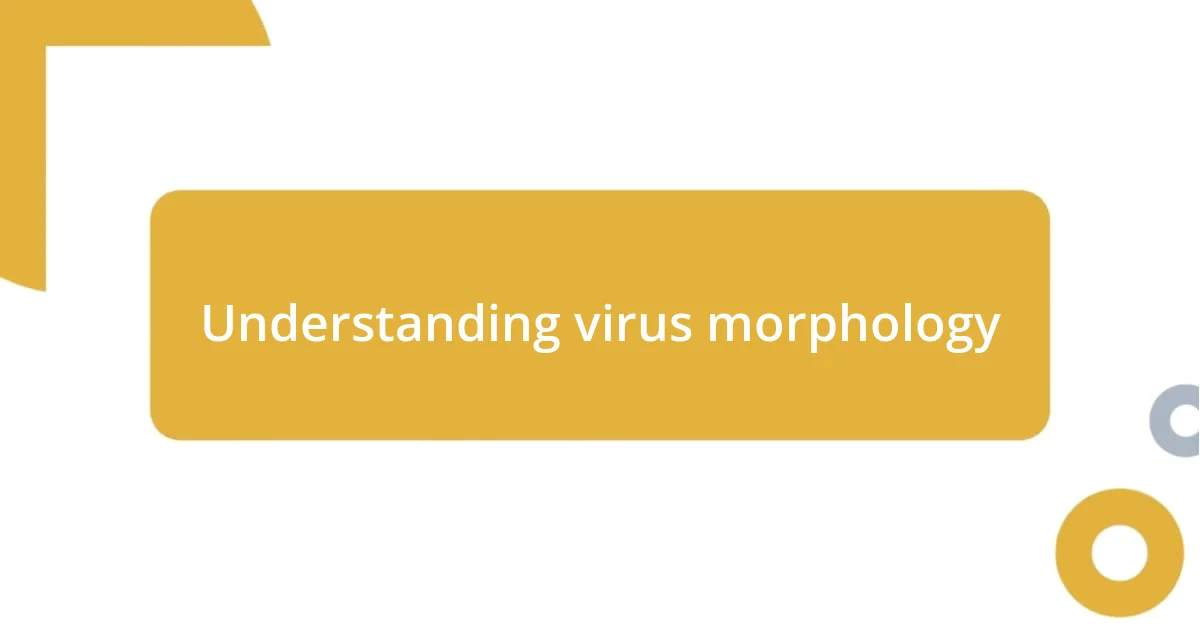
Understanding virus morphology
Virus morphology refers to the size, shape, and structural features of a virus, and understanding these aspects is crucial for classification. When I first delved into this topic, the diversity of viral forms— from helical to icosahedral— struck me deeply. How can something so tiny and simple be the source of such complex behaviors in living organisms?
One memorable experience I had was observing electron microscope images of various viruses. Seeing the differences in their morphology—like the unique spikes of coronaviruses versus the smooth surfaces of certain bacteriophages—made the concept come alive for me. Each shape tells a story, almost like a fingerprint, revealing how viruses interact with their hosts and how they might be targeted by treatments.
Moreover, studying virus morphology isn’t just about appreciating their diverse structures; it allows us to connect the dots between form and function. For instance, the rigid structure of some viruses may enhance their stability in extreme conditions, raising questions about how they survive outside a host. It’s intriguing to ponder how their morphology contributes to their evolutionary success.
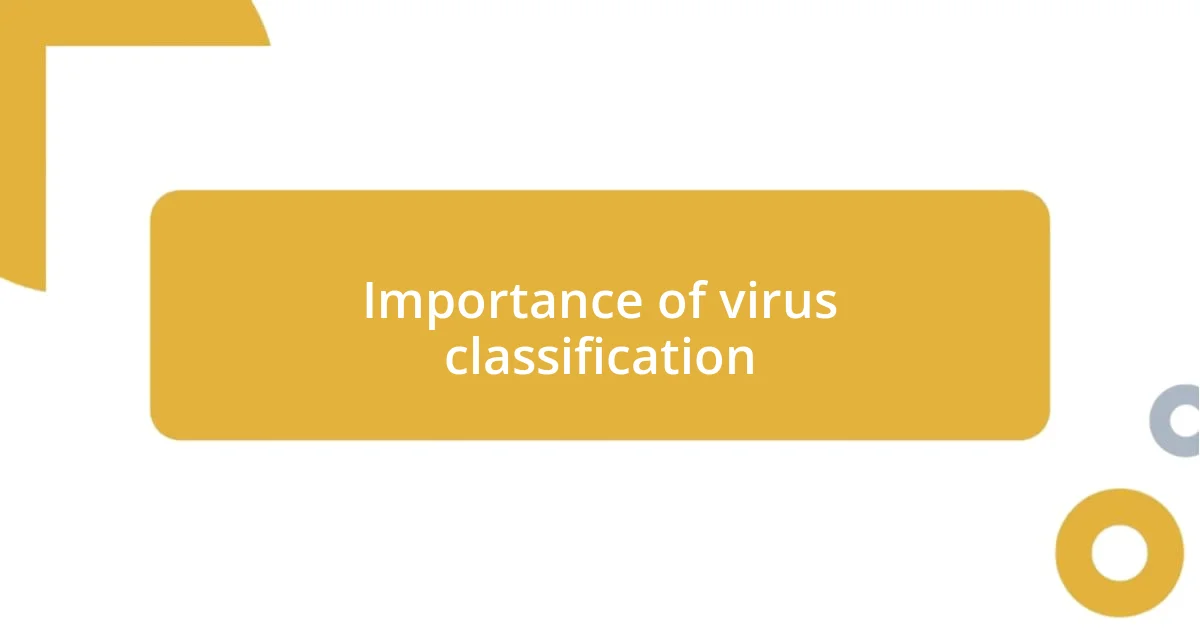
Importance of virus classification
When I think about virus classification, its significance becomes immediately apparent. By accurately classifying viruses, we create a foundation for diagnosing infections and developing vaccines. In my experience, understanding the relationships between different viral families helps researchers anticipate outbreaks and enhance public health responses.
Here’s why virus classification matters:
- Disease Management: Identifying virus types allows for tailored treatments and effective vaccines.
- Understanding Evolution: Classification sheds light on viral evolution and spread, helping us track emerging threats.
- Research Advancements: It guides scientific inquiries, leading to breakthroughs in virology.
- Public Health Initiatives: A well-classified virus informs policy decisions and outbreak control measures.
Reflecting on my own research journey, I’ve often felt the excitement and urgency of classification work—like the rush I felt during a collaborative effort to classify a previously unstudied virus. The thrill of piecing together clues from its morphology was genuinely exhilarating. That rush fuels my commitment to this critical aspect of virology.
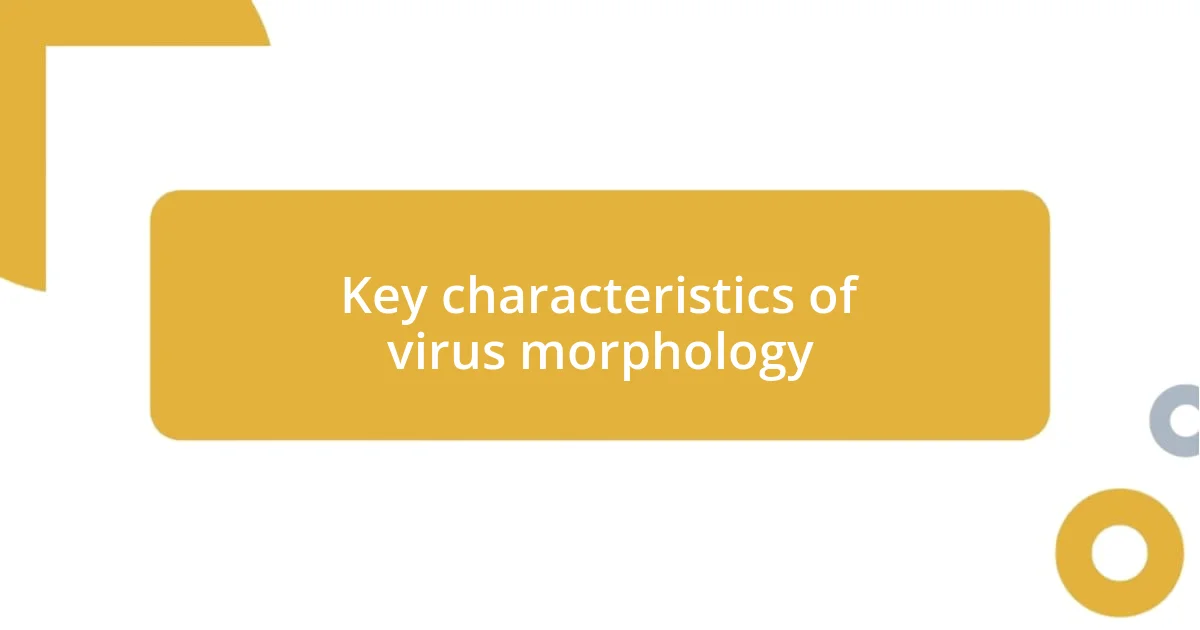
Key characteristics of virus morphology
Understanding virus morphology unlocks a treasure trove of insights. I remember a specific project where examining the sizes of various viruses revealed just how much a few nanometers could make a difference. For example, the smaller the virus, the more readily it can enter cells, which often affects how it propagates. This realization hit me hard; such tiny differences have vast implications.
Another compelling characteristic of virus morphology is symmetry, which I find incredibly fascinating. I once compared the symmetrical structure of a bacteriophage with its asymmetrical counterpart. The contrast was illuminating. Those symmetrical shapes often lend themselves to stability, allowing viruses to endure harsh environments. I couldn’t help but feel a sense of awe observing how nature finely tunes these structures for survival.
The envelope surrounding some viruses can dramatically change their infectivity. I vividly recall experimenting with enveloped and non-enveloped viruses in my lab. Seeing how the lipid bilayer influenced the virus’s ability to enter host cells felt like witnessing a delicate dance. It’s interesting to think about how these morphological characteristics inform both treatment strategies and our understanding of viral behavior.
| Characteristic | Description |
|---|---|
| Size | Varies widely, influencing the ability to infect host cells. |
| Shape | Common forms include helical and icosahedral, affecting stability and transmission. |
| Symmetry | Symmetrical structures often enhance stability and are crucial for virus survival. |
| Envelope | Viruses can be enveloped or non-enveloped, impacting their infective capabilities and resistance to environmental stress. |

Techniques for studying virus morphology
Studying virus morphology requires a blend of advanced techniques that can be both intricate and fascinating. One method I frequently use is electron microscopy, which provides stunningly detailed images of viral structures. I recall the first time I viewed a virus under this microscope—it was like peering into a hidden world. The clarity of the images revealed the layers and shapes within the virus that I had only conceptualized before.
Another technique that has proven invaluable is cryo-electron tomography. This method preserves the virus in a near-native state, allowing us to see its morphology without the distortions caused by traditional preparation. I remember how amazed I was when our lab implemented this technique for the first time. Observing the three-dimensional architecture of a virus gave me a profound appreciation for its complexity and adaptability. How could such small entities, made of just protein and genetic material, exhibit such remarkable diversity?
In addition to imaging techniques, I often delve into molecular biology methods to analyze viral components. Techniques like X-ray crystallography can pinpoint molecular structures, providing insights into how these forms influence virus function and infectivity. I remember a project where this technique helped identify anomalies in viral proteins, leading us to rethink classification criteria. It’s moments like this that get my mind racing—how often can a single discovery shift our understanding of an entire viral family?
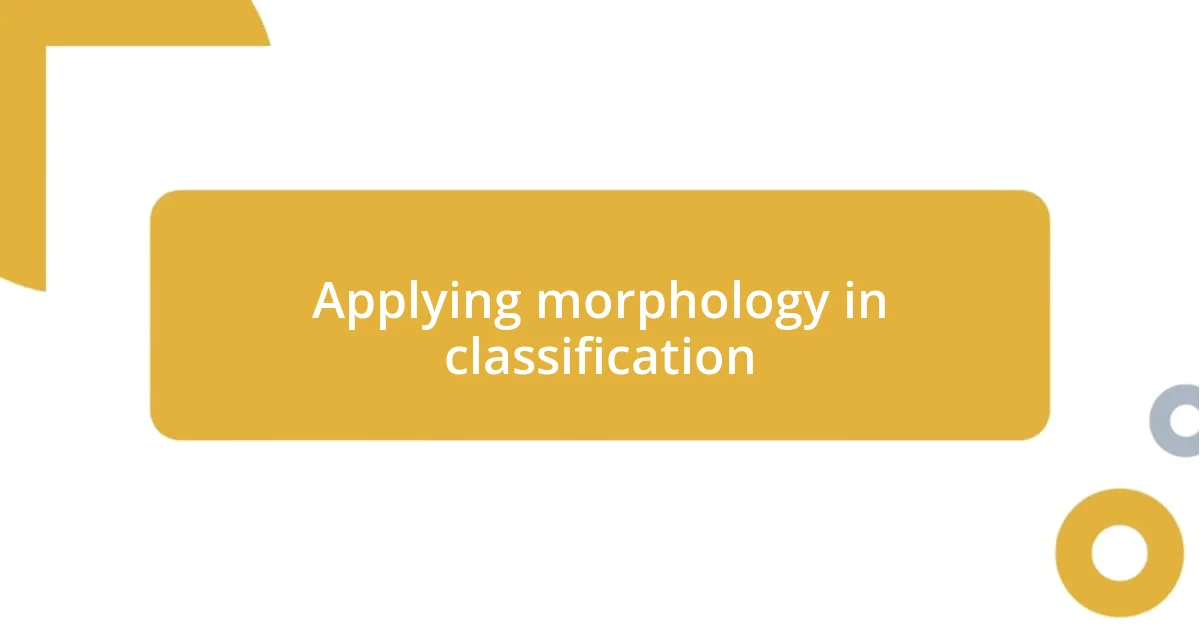
Applying morphology in classification
Applying morphology in classification goes beyond mere observation; it’s about making connections between structure and functionality. I recall analyzing the shape of a specific virus and how it aligned with its transmission pathways. This wasn’t just theoretical; witnessing how those structural traits influenced the virus’s ability to spread really hit home. How could such intricacies not play a role in deciding how we classify these entities?
The morphology often dictates how we understand a virus’s behavior and potential threats. I vividly remember a time when I was categorizing viruses based on their symmetry, and it led to a surprising discovery about their resilience in different environments. It’s fascinating to consider how a simple change in symmetry can alter a virus’s survival—the realization that structural details hold the key to broader classification criteria is exhilarating. Isn’t it astounding how something so small can reshape our entire understanding?
When I apply all this knowledge to classification, I find myself blending morphological observations with functional analysis. For example, the presence of an envelope is a pivotal factor in how I place a virus on the classification tree. I often think about the implications during my research sessions; recognizing that the envelope does not just add a layer but plays a critical role in host interactions. It makes me wonder, how can we fully appreciate the complexity of these tiny life forms without exploring their shapes?
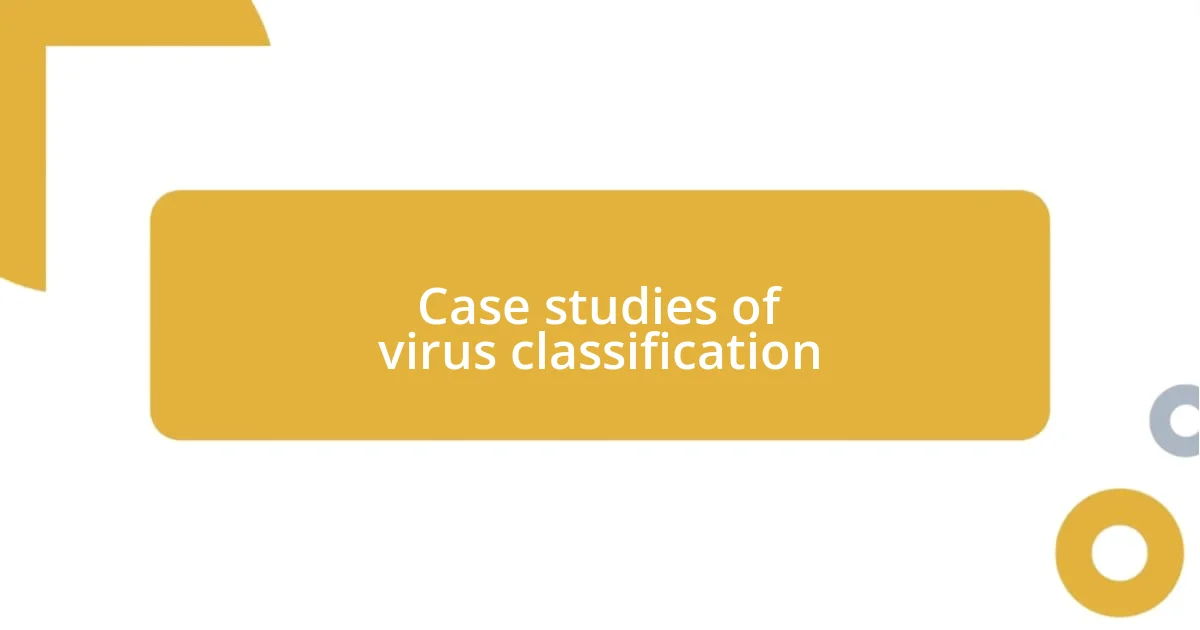
Case studies of virus classification
During my research on virus classification, there was a pivotal moment when I was part of a team studying a particularly elusive virus. Analyzing its morphology via atomic force microscopy revealed intricate surface structures that had never been documented before. I remember the excitement in the lab as we pieced together how these features played a role in its interaction with host cells. I found myself asking, how could such detail change our approach to understanding its pathogenicity? Those revelations truly illuminated the enormous impact of morphology in shaping our classification efforts.
One case study that stands out involved a family of viruses that displayed remarkable symmetry. As I examined their structural designs, I could almost feel the connection between their shapes and their ecological niches. It was as if the virus was presenting its credentials, saying, “This is where I thrive.” This experience reinforced my belief that morphological characteristics aren’t just beautiful constructs; they are fundamental to unraveling the deep evolutionary relationships among viral entities. How often do we overlook the elegance of symmetry in our quest for understanding?
I also explored a group of emerging viruses and found that subtle differences in their capsid structures led to significant variations in infectivity and transmissibility. That realization was like a light bulb moment for me. I mean, who would have thought that a small tweak in capsid morphology could result in such different behaviors? This underscored the importance of comprehensive morphological analysis in virus classification. Have you ever considered how a simple shape can redefine our entire approach to viral research? It’s a reminder of the intricate web of connections that exists in the microbial world.
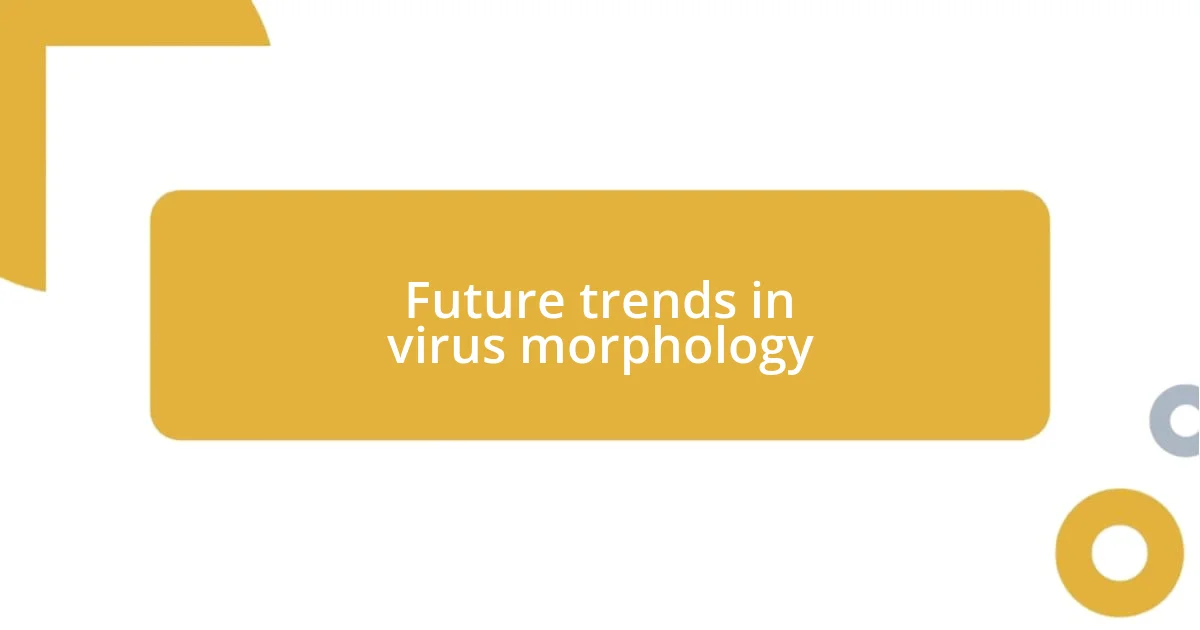
Future trends in virus morphology
The future of virus morphology research holds exciting potential, particularly with advancements in imaging techniques. I remember the thrill of using cryo-electron microscopy for the first time. It was a game changer, revealing intricate viral structures that reshaped my perspective on classification. Can you imagine the insights we’ll gain as these technologies evolve further? The detail we can capture will deepen our understanding and classify viruses in ways we never thought possible.
As I look ahead, I can’t help but think about the role of artificial intelligence in analyzing morphological data. The idea of algorithms that can recognize patterns in viral shapes makes my mind race with possibilities. When I experimented with machine learning models on morphological attributes, the results were astonishing—patterns emerged that would have taken me years to identify alone. Isn’t it intriguing how technology might enhance our natural capabilities and lead to breakthroughs in classification? It feels like we are on the brink of a paradigm shift.
Moreover, the integration of morphological data with genomic sequencing seems poised to redefine how we classify viruses. Reflecting on my experiences, I recall grappling with cases where morphology and genetics appeared incongruent. With enhanced methods for combining these data streams, what surprises might we uncover? I envision a future where understanding a virus’s shape not only informs us about its classification but also its evolutionary trajectory and potential threats. This synthesis could unlock a deeper comprehension of viral behavior, providing us with the tools needed to tackle emerging challenges in virology.














